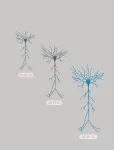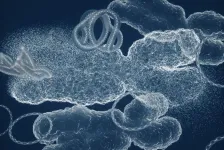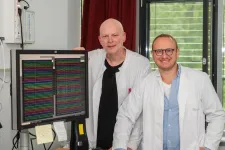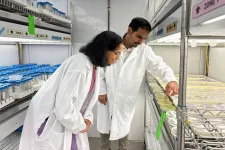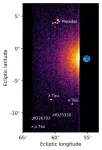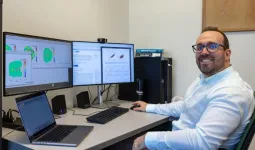(Press-News.org) New research from the Max Planck Florida Institute for Neuroscience published this week in Nature has identified a key step in how neurons encode information on timescales that match learning.
A timing mismatch
Learning takes seconds to minutes. However, the best-understood mechanisms of how the brain encodes information happen at speeds closer to neural activity—around 1000 times faster. These mechanisms, known as Hebbian plasticity, suggest that if two connected neurons are both active within a hundredth of a second, then the connection between the two neurons is strengthened. In this way, information arriving at connected neurons within this short time window can be linked. However, during behavior, information that needs to be encoded together is often separated by seconds to minutes. How, then, can neurons integrate information on timescales relevant to learning?
A new model of learning
Recently, a new neural model of information encoding called behavioral timescale synaptic plasticity (BTSP) addressed this discrepancy by demonstrating that neurons can integrate information over seconds, a timescale consistent with behavior. Indeed, during behaviors such as navigation, neurons encode specific locations through BTSP. However, the molecular mechanisms of how neurons implement BTSP were unknown.
This week, a research team led by Dr. Anant Jain, Dr. Yoshihisa Nakahata, and Scientific Director Dr. Ryohei Yasuda identified key aspects of how BTSP works in neurons, reporting their years-long study into this critical model of plasticity.
Dr. Yasuda describes the team’s motivation for the project, “Understanding the precise molecules and mechanisms that neurons use to encode information is critical for understanding brain function and health. Research in this area has primarily focused on traditional plasticity models, which may be less relevant to learning during experience. It is critical to explore the molecular mechanisms that underlie new plasticity models, such as BTSP.”
The team’s first hurdle was modeling BTSP in isolated brain tissue, where they could precisely measure the resulting neuronal changes. The researchers were able to trigger BTSP by inputs separated by ~1 second, confirming the extended integration time of information storage. The team also found that BTSP occurs at single synapses, a property critical for specificity in information coding. By combining electrophysiological measurements of neuronal activity with specialized microscopy and biosensors, the team could visualize real-time molecular changes that occurred during BTSP to determine their role.
CaMKII: Same player, different role
The research team focused on a molecule called CaMKII, which is well-known for its critical role in many types of plasticity in neurons.
“We hypothesized that CaMKII would be critical for BTSP. This molecule is activated at synapses and can remain active for many seconds. It seemed the perfect candidate to be the key player in extending the time window of information integration in neurons,” described Dr. Jain. “Well, it turns out that we were right – CaMKII was critical for BTSP, but we were completely wrong about its role.”
When the research team disrupted the function of CaMKII, BTSP was disrupted. Wanting to visualize the CaMKII activity in neurons during the BTSP process, the group optimized a biosensor to report when CAMKII was active. Using this newly optimized sensor, with nearly two-fold improved sensitivity over previous tools, the scientists could measure CAMKII activity during BTSP. However, they didn’t find what they expected.
Contrary to their hypothesis, they found no detectable CaMKII activation during BTSP induction. Instead, a delayed and stochastic activation of CaMKII occurred tens of seconds after initiating BTSP. In addition, while the plasticity was happening at a specific synapse, CaMKII was active in a much larger area of the neuron. The research revealed that CaMKII is an instructive signal for BTSP but does not define the synapse specificity of plasticity. It suggests a broad time window for synaptic plasticity and a new model of how synapse-specific and instructive signals can integrate over tens of seconds.
“This is a paradigm shift in our view of CaMKII function and our understanding of plasticity mechanisms. The activity of CaMKII throughout the dendrite reveals that it does not define synapse specificity of plasticity, but rather is involved in dendritic information processing. Our results have opened many more questions for further investigation, including what defines the specificity of information coding at single synapses or the time-delay in CAMKII activation,” describes Dr. Jain. “The surprising findings underscore the importance of behaviorally relevant models of information encoding in the brain to reach our ultimate goal of linking molecular activity to memory formation and preventing neurological disorders involving learning and memory dysfunction.”
Link to original research
About the Max Planck Florida Institute for Neuroscience:
The Max Planck Florida Institute for Neuroscience is dedicated to unraveling the mysteries of the brain by advancing our understanding of neural circuits and synaptic plasticity. Researchers at the institute focus on how neurons communicate and adapt, contributing to learning, memory, and behavior.
This research was funded by the National Institute of Heath and the Max Planck Society. This content is solely the authors’ responsibility and does not necessarily represent the official views of the funders.
END
Extended Timing: How neurons encode information on timescales that match learning
2024-10-09
ELSE PRESS RELEASES FROM THIS DATE:
Dual immunotherapy plus chemotherapy benefits specific subset of patients with lung cancer
2024-10-09
HOUSTON ―Researchers from The University of Texas MD Anderson Cancer Center have demonstrated that patients with metastatic non-squamous non-small cell lung cancer (NSCLC) harboring specific mutations in the STK11 and/or KEAP1 tumor suppressor genes were more likely to benefit from adding the immunotherapy tremelimumab to a combination of durvalumab plus chemotherapy to overcome treatment resistance typically seen in this patient population.
Study results, published today in Nature, identify ...
Scientists discover viral trapdoor blocking HIV and herpes
2024-10-09
Scientists discover viral trapdoor blocking HIV and herpes
Ghent, 10 October 2024 – A group of researchers led by Xavier Saelens and Sven Eyckerman at the VIB-UGent Center for Medical Biotechnology discovered how a protein linked to the human immune system wards off HIV-1 and herpes simplex virus-1 by assembling structures in the cell that lure in these viruses and then trap them or even take them apart. The research was spearheaded by first author George Moschonas, published in Cell Host and Microbe, and could be used to devise new strategies to combat these viruses.
The innate immune system of the human body can sense and respond to viruses by ...
Study uncovers mutations and DNA structures driving bladder cancer
2024-10-09
How bladder cancer originates and progresses has been illuminated as never before in a study led by researchers at Weill Cornell Medicine and the New York Genome Center. The researchers found that antiviral enzymes that mutate the DNA of normal and cancer cells are key promoters of early bladder cancer development, and that standard chemotherapy is also a potent source of mutations. The researchers also discovered that overactive genes within abnormal circular DNA structures in tumor cells genes drive bladder cancer resistance to therapy. These findings are novel insights into bladder cancer biology and point to new therapeutic strategies for this ...
A matter of taste: Electronic tongue reveals AI inner thoughts
2024-10-09
UNIVERSITY PARK, Pa. — A recently developed electronic tongue is capable of identifying differences in similar liquids, such as milk with varying water content; diverse products, including soda types and coffee blends; signs of spoilage in fruit juices; and instances of food safety concerns. The team, led by researchers at Penn State, also found that results were even more accurate when artificial intelligence (AI) used its own assessment parameters to interpret the data generated by the electronic tongue.
The researchers published their results today (Oct. 9) in Nature.
According to the researchers, ...
Another step towards decoding smell
2024-10-09
We often only realize how important our sense of smell is when it is no longer there: food hardly tastes good, or we no longer react to dangers such as the smell of smoke. Researchers at the University Hospital Bonn (UKB), the University of Bonn and the University of Aachen have investigated the neuronal mechanisms of human odor perception for the first time. Individual nerve cells in the brain recognize odors and react specifically to the smell, the image and the written word of an object, for example a banana. The results of this study close a long-standing knowledge gap between animal and human odor research and have now been published in the renowned ...
Plant Science Research collaboration will explore key mosses critical to storing carbon
2024-10-09
ST. LOUIS, MO, October 9, 2024 - Plant scientists at the Donald Danforth Plant Science Center and the HudsonAlpha Institute for Biotechnology have been awarded a four-year National Science Foundation (NSF) Enabling Discovery through GEnomics (EDGE) grant to advance their understanding of sphagnum moss, a crucial component of peatlands and a vital player in global ecosystems. The collaborative research team will develop genetic and genomic resources to study sphagnum's life cycle, growth, and adaptation to various environmental conditions.
Sphagnum ...
Researchers examine the persistence of invisible plastic pollution
2024-10-09
Plastic pollution – tiny bits of plastic, smaller than a grain of sand – is everywhere, a fact of life that applies even to newborn rodents, according to a Rutgers Health study published in the journal Science of the Total Environment.
Researchers have long understood that micro- and nanoplastic particles (MNPs), which enter the environment through oxidation and natural degradation of consumer products, are easily deposited in the human body through inhalation, absorption and diet.
Experts also understand that these pollutants can cross the placental barrier and deposit ...
Coffee during pregnancy safe for baby’s brain development
2024-10-09
A University of Queensland-led study has failed to find any strong links between drinking coffee during pregnancy and neurodevelopmental difficulties in children, but researchers are advising expectant mothers to continue following medical guidelines on caffeine consumption.
Dr Gunn-Helen Moen and PhD student Shannon D’Urso from UQ’s Institute for Molecular Bioscience (IMB) led an in-depth genetic analysis of data from tens of thousands of families in Norway.
“Scandinavians are some of the biggest coffee consumers in the world, drinking at least 4 cups a day, with little stigma about drinking coffee during pregnancy,” ...
SwRI-led instrument aboard Jupiter-bound spacecraft nails in-flight test
2024-10-09
SAN ANTONIO — October 9, 2024 —As European Space Agency (ESA)’s Jupiter Icy Moons Explorer (Juice) spacecraft hurtled past the Moon and Earth in mid-August to provide its first gravity assist maneuver to the Jovian system, the Southwest Research Institute-led Ultraviolet Spectrograph (UVS) instrument imaged the UV emissions radiating from the Earth and Moon.
It was a successful test of one of three science instrument projects comprising NASA’s contribution to ESA’s Juice mission. The UVS data collected were then analyzed and found to be consistent with expectations for the Moon and the Earth. This confirmation that the instrument works ...
New AI models of plasma heating lead to important corrections in computer code used for fusion research
2024-10-09
New artificial intelligence (AI) models for plasma heating can do more than was previously thought possible, not only increasing the prediction speed 10 million times while preserving accuracy, but also correctly predicting plasma heating in cases where the original numerical code failed. The models will be presented on October 11 at the 66th Annual Meeting of the American Physical Society Division of Plasma Physics in Atlanta.
“With our intelligence, we can train the AI to go even beyond the limitations ...
